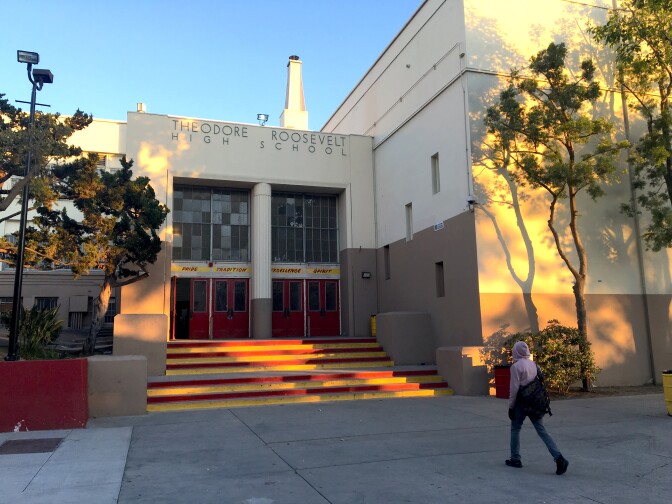Truth matters. Community matters. Your support makes both possible. LAist is one of the few places where news remains independent and free from political and corporate influence. Stand up for truth and for LAist. Make your year-end tax-deductible gift now.
This archival content was originally written for and published on KPCC.org. Keep in mind that links and images may no longer work — and references may be outdated.
Does rebuilding LAUSD's Roosevelt High require bulldozing its history?
In Magdalena Ceja's classroom, mice scurry in and out. Electrical outlets in her wall, which power technology Ceja needs to teach, fail. Tiles fall from the ceiling, which leaks in places.
Crumbling facilities are the norm at Roosevelt High School in Los Angeles' Boyle Heights neighborhood, a 96-year-old campus that made the history books in 1968 when students walked out to protest unequal conditions for Latinos in the L.A. Unified School District — including, ironically, inadequate facilities.
"It's been normalized," said Ceja, who herself graduated from Roosevelt in 2011 before returning to teach. "'Oh look, it's the classroom mouse' … which I think is part of the problem. If students have normalized the idea that the school doesn't care about them, then they've also normalized the idea they shouldn't care about school."

Now, L.A. Unified officials are ready to give the Roosevelt campus a badly-needed upgrade. The district has proposed a $173 million project to rebuild the high school by demolishing 11 structures on the Roosevelt campus — including the original, culturally-significant "R Building" — and erecting six gleaming, modern buildings in their place.
Few dispute Roosevelt is long-overdue for better facilities. But some Roosevelt alumni and preservationists say the project goes too far, demolishing a symbol of the 1968 walkouts. They say the district has not fully explored ways to allow the R Building to be renovated rather than razed.
"If they tear down the R Building, they're tearing down Roosevelt," said Roosevelt alum Cesar Romo, who still lives in Boyle Heights. "They're cutting our history out."
"We can have it all," said another alum, Vivian Escalante. "We can have the R Building … We can have our history. We can have modernization."

But current Roosevelt students and teachers are pushing for the total re-build to proceed. Some even argued the rebuild is a fulfillment of demands students at Roosevelt — and four other East L.A. campuses — made in 1968.
"The East L.A. Walkouts, that is important to preserve as part of the history in Roosevelt," said student Xochil Ramirez. "But when you look at the context and the demands they were making at the time, they were demanding better resources. They were demanding larger classrooms."
The L.A. Unified School Board will likely vote whether to give final approval to the Roosevelt project this spring as part of a broader $7.8 billion bond-funded effort that will result in significant facilities overhauls on 22 district campuses.
L.A. Unified officials said preserving the R Building would require major, costly seismic renovations that would ultimately cost much more than tearing the building down.
A draft report by environmental consultants Impact Sciences, Inc., does contemplate the possibility of leaving the R Building intact and constructing new classroom buildings around it. But the report concluded a renovation was not practical, not only because of the cost, but because the seismic retrofits would reduce the number of usable classrooms in the building more than in half — from 48 to 21.
In a statement, district spokeswoman Elvia Perez Cano said L.A. Unified officials considered these factors, as well as community input, in drawing up the current proposal, which she said "will include additional features to honor Roosevelt High School’s rich and diverse culture and history, including, but not limited to its association with the walkouts."
But Roosevelt preservationists fear the district is simply charging ahead with its re-build plans without giving community members the tools they need to weigh alternatives to the re-building project, including the R Building renovation.
"It would be really helpful to see maps or visuals that show what all of the alternatives look like so that people can actually understand better what the alternatives are for this project," said Rosalind Sagara, neighborhood outreach coordinator for the L.A. Conservancy. "It's very easy to dismiss an alternative based on a couple paragraphs."
Opponents of tearing down the R Building mostly center their arguments around a desire to preserve a slice of history — but because this is Boyle Heights, some of their arguments are tinged with fears about new housing developments forcing out long-time residents. They fear a shining new school will make the neighborhood all the more attractive to developers, thus accelerating gentrification.
"The community has been hearing this repetitive mantra of, 'It's for our kids,'" said Jorge Castañeda, a community organizer with the Coalition to Preserve L.A. "And the question becomes, 'Is it, if the families cannot afford to live within the boundaries to send their kids to this school?'"
Teacher Magdalena Ceja points out opponents don't have to live with the day-to-day of an inadequate facility — and said she feels a new building itself helps students build pride in their school, and thus in their own education.
"I really think," said Ceja, who teaches ethnic studies, "that if you give students a school they can be proud of and say, 'This is my school, I have computers in my classrooms, can walk through the campus and say that I feel proud to go to Roosevelt,' then I think achievement follows that."
"'We care about you enough to invest in a new building for you.' Then students see that and think, 'If they care about me enough to do that, maybe I can should care about my own education too.'"
This story was updated to include the district statement.










